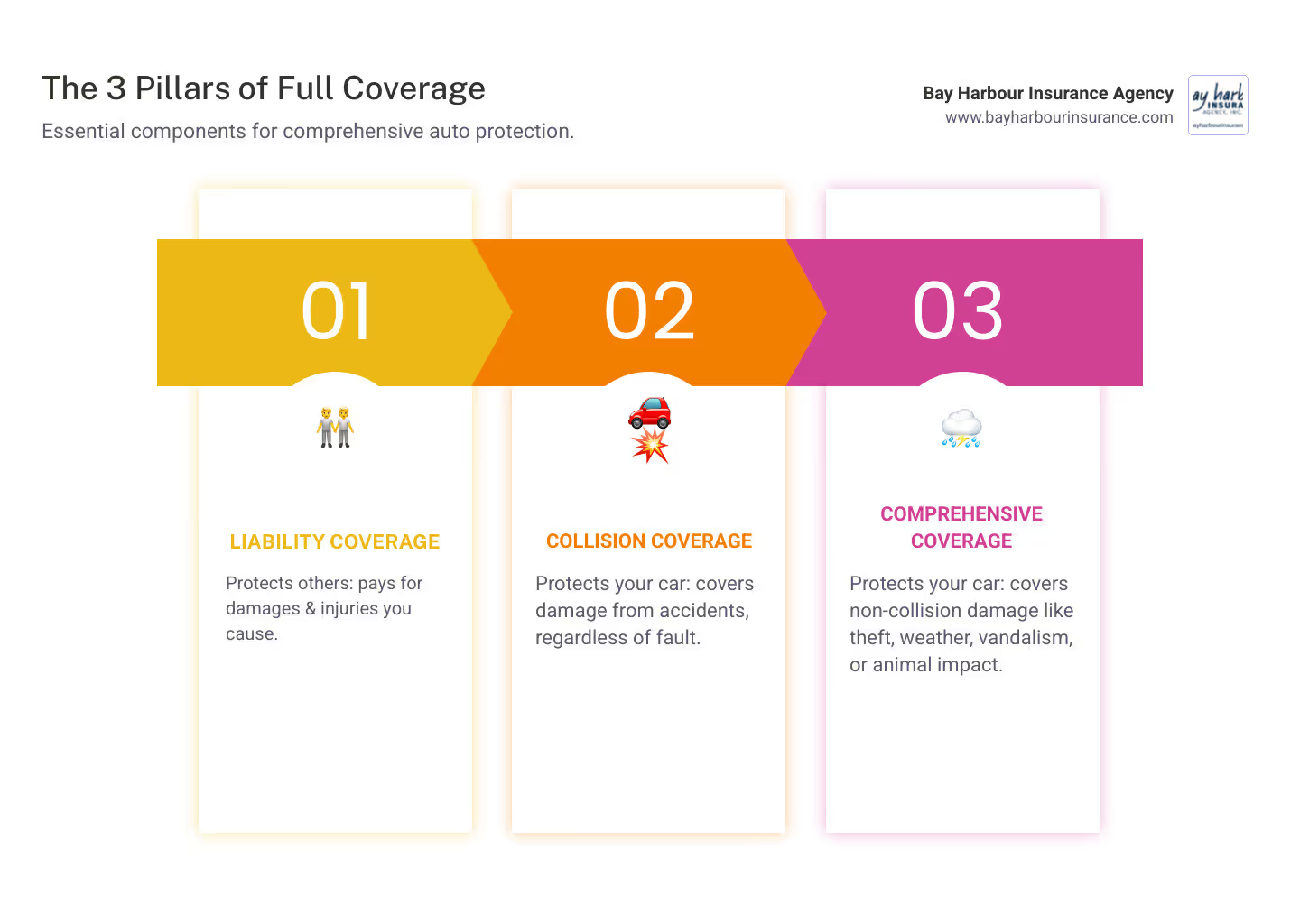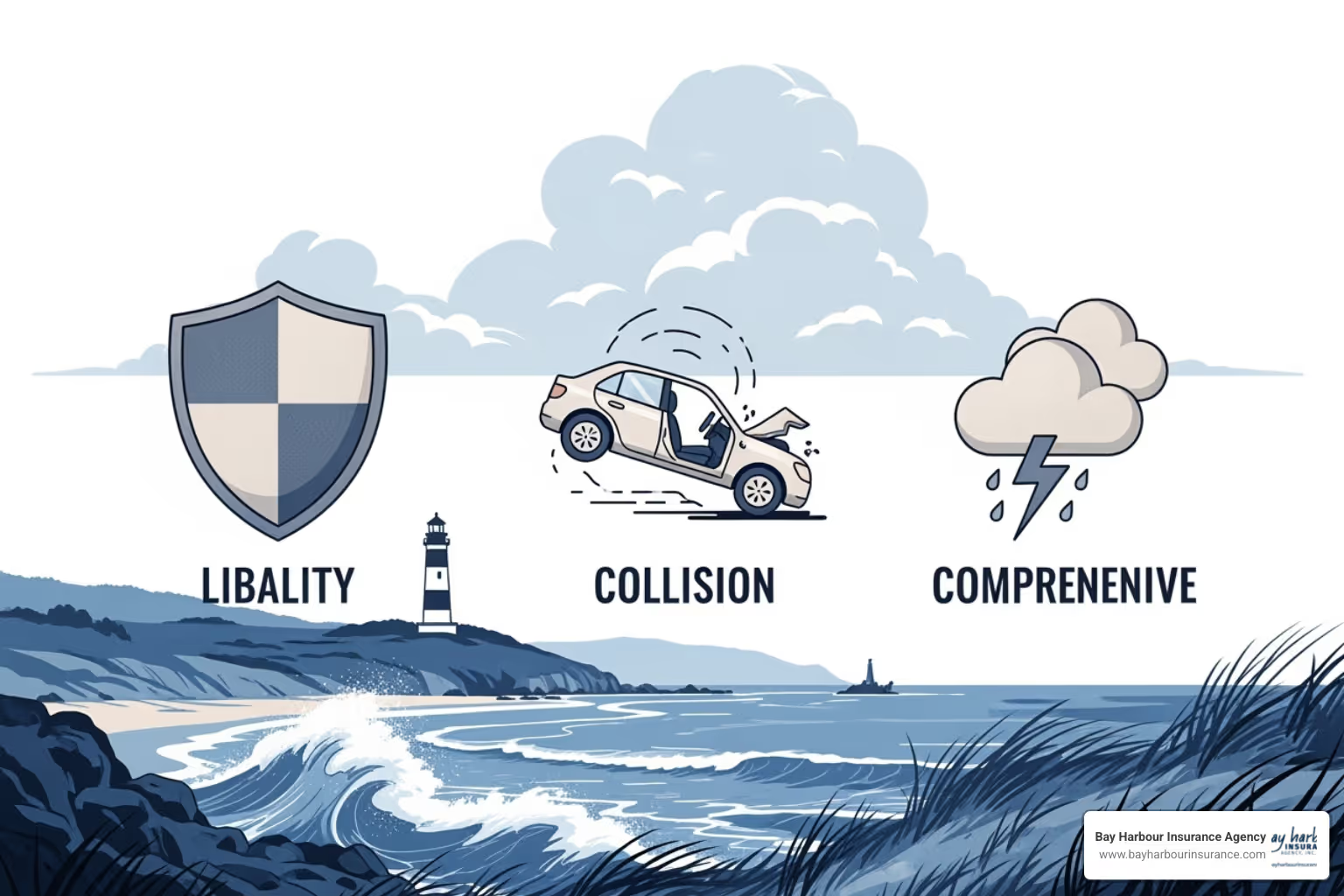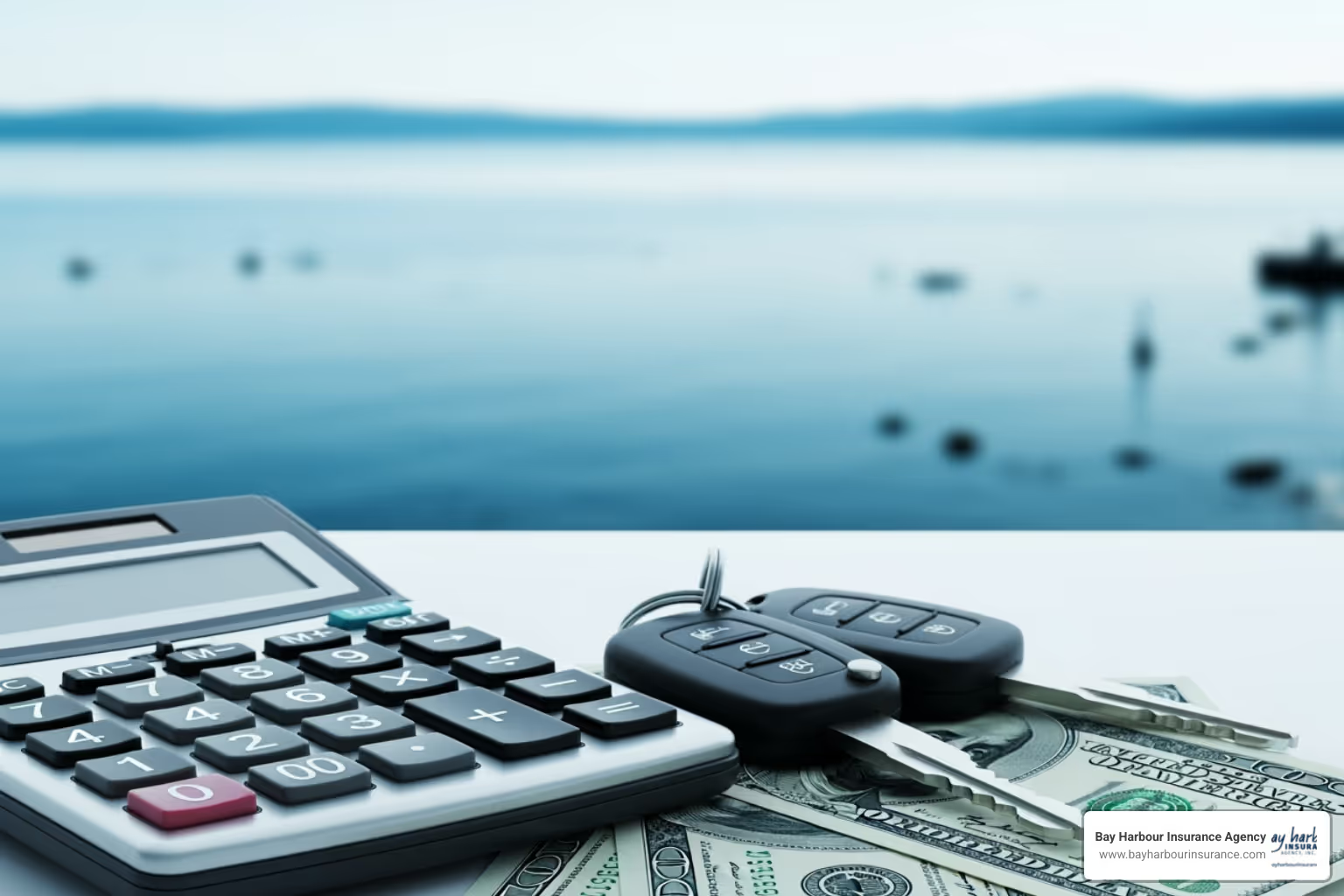
The Whole Shebang: A Guide to Full Coverage Car Insurance
October 10, 2025
Understanding Full Coverage Car Insurance: What You Need to Know
Full coverage car insurance isn't actually a specific type of insurance policy - it's a common term that describes a combination of different coverages working together to protect you and your vehicle.
What Full Coverage Typically Includes:
- Liability Coverage - Pays for damage you cause to others
- Collision Coverage - Pays to fix your car after accidents
- Comprehensive Coverage - Pays for non-accident damage (theft, weather, vandalism)
- Additional Coverages - May include uninsured motorist, medical payments, and other protections
Key Points to Remember:
- No insurance policy called "full coverage" exists
- It's a consumer-friendly term for multiple coverages bundled together
- Provides more financial protection than basic liability-only insurance
- Required by lenders for financed or leased vehicles
- Costs more than liability-only but offers significantly better protection
The term "full coverage" can mean different things to different insurance companies. Some include extras like rental car coverage or roadside assistance, while others stick to the basic trio of liability, collision, and comprehensive.
Understanding what's actually included in your policy matters more than the label.
For Long Island drivers, full coverage becomes especially important given our dense traffic, weather challenges, and higher vehicle values. Whether you're commuting to Manhattan or just running errands around Nassau County, having comprehensive protection gives you peace of mind on every drive.

Decoding 'Full Coverage': What It Really Means
While the name full coverage car insurance in Long Island sounds like it covers everything, it's actually a bundle of different protections. It goes far beyond the state-required minimum, creating a financial safety net for damage you might cause and damage to your own vehicle. The exact combination can vary, but the core components are consistent across most policies.
The Core Components of a Full Coverage Car Insurance Policy
When we break down full coverage car insurance, we're really talking about three main players. These are the coverages that separate a robust policy from basic, bare-bones protection.

Liability coverage is the foundation of your policy and is required by law in New York. It provides financial protection when you're at fault in an accident. Bodily injury liability covers medical bills and lost wages for those you injure, while property damage liability pays for damage to someone else's car or property. State minimums are often insufficient for serious accidents, so we recommend considering higher limits.
Collision coverage protects your car. It helps pay to fix or replace your vehicle if it's damaged in a collision with another object or car, regardless of who is at fault. Lenders require this coverage for financed or leased vehicles to protect their investment—and you should want to protect yours, too.
Comprehensive coverage handles damage to your car from non-collision events. This includes theft, vandalism, natural disasters (like hail or floods), falling objects, and hitting an animal. Many policies also cover glass damage, often with a lower deductible.
These three coverages work together like a well-oiled machine, protecting you from most of the financial risks you'll face as a driver. For more details about New York-specific coverage options, check out our guide on NY vehicle insurance quotes.
Optional Coverages That Improve Your Policy
The beauty of full coverage car insurance is that you can customize it to fit your life perfectly. Think of these optional coverages as upgrades that can turn good protection into great protection.
Uninsured and underinsured motorist coverage is crucial on Long Island. It protects you when an at-fault driver has no insurance or not enough to cover your damages.
Personal injury protection (PIP) is required in New York and covers medical bills and lost wages for you and your passengers, regardless of fault. Medical payments coverage is an optional add-on that also helps with medical bills.
Gap insurance is essential for financed or leased cars. If your car is totaled, it covers the "gap" between what you owe and what the car is worth.
Rental reimbursement pays for a rental car while yours is being repaired after a covered claim. Roadside assistance helps with flat tires, dead batteries, and lockouts.
Accident forgiveness can prevent your rates from increasing after your first at-fault accident. Waiver of depreciation ensures you get the full replacement value if your new car is totaled.
Common Exclusions: What Full Coverage Doesn't Include
Even though full coverage car insurance offers extensive protection, it doesn't cover absolutely everything. Knowing these exclusions helps avoid unpleasant surprises later.
Intentional damage to your own vehicle won't be covered - insurance is for accidents, not revenge against your car. Wear and tear and mechanical breakdowns from normal aging aren't covered either. Insurance handles sudden, unexpected events, not your transmission giving up after 200,000 miles.
Commercial use of your personal vehicle usually isn't covered. If you're driving for Uber, delivering food, or using your car for business, you'll need commercial coverage for those activities.
Custom parts and equipment often need special coverage. Your expensive aftermarket stereo system or custom rims might not be fully covered under standard comprehensive coverage. Racing activities and off-road driving in unauthorized areas are typically excluded too.
Vehicle impoundment costs and personal belongings stolen from your car generally aren't covered. Your laptop or golf clubs would typically be covered by your homeowners or renters insurance instead.
Understanding these exclusions helps you make informed decisions about your coverage. For more information about factors that affect auto insurance pricing, you can reference what determines the price of an auto insurance policy.
The Price of Peace of Mind: How Much Does Full Coverage Car Insurance Cost?
Yes, full coverage car insurance costs more than basic liability, but it's an investment in financial security and peace of mind. The higher price reflects the comprehensive protection for your own vehicle, which is a greater risk for the insurance company. Understanding what drives these costs can help you find affordable coverage without sacrificing protection.
Average Costs and Key Influencing Factors

The cost of full coverage car insurance varies dramatically based on a mix of factors.
Where you live makes a huge difference. Areas with heavy traffic, higher crime rates, or frequent severe weather, like we see on Long Island, typically have higher premiums. New York's specific insurance requirements also play a role. If you're curious about the specifics of New York pricing, check out our detailed guide on How Much for Auto Insurance NY.
Your age and driving experience significantly impact your rates. Younger, less experienced drivers face the steepest premiums, but rates typically drop as you gain experience and maintain a safe record.
Your driving record is one of the most powerful factors. A clean record earns the best rates, while tickets and accidents, especially serious violations like DUIs, can increase costs dramatically.
The car you drive matters. Expensive vehicles, luxury cars, and sports cars cost more to insure because they're pricier to repair or replace. The safety ratings and theft rates for your specific model also influence your premium.
Your credit history can affect your rates in most states, as insurers have found a correlation between credit scores and claims filed.
Your deductible choice gives you direct control. A higher deductible (the amount you pay out-of-pocket on a claim) leads to a lower premium, while a lower deductible means you'll pay more each month.
Smart Strategies to Make Full Coverage Car Insurance More Affordable
Nobody wants to overpay for insurance. Here are several smart strategies to make full coverage car insurance more budget-friendly.
Raising your deductible is a quick way to lower your premium. Choosing to pay more out-of-pocket in a claim (e.g., $1,000 vs. $500) will reduce your monthly bill. Just be sure you can afford the amount you choose.
Bundling your policies offers significant savings. Most insurers provide a discount when you combine your auto insurance with a homeowners or renters policy.
Paying your premium annually or semi-annually can save you money by avoiding the processing fees often charged for monthly installments.
Maintaining a clean driving record is the best long-term strategy for low rates. Safe driving proves you're a low-risk customer.
Taking advantage of safety features in your vehicle, like anti-lock brakes, airbags, and anti-theft devices, can earn you discounts.
Usage-based insurance programs can lead to substantial savings by tracking safe driving habits like braking and speed. Learn more about Usage-Based Insurance to Save Money.
Shopping around and comparing quotes is essential, as rates vary significantly between companies. As an independent agency, we do this for you, comparing options from multiple insurers to find the best combination of coverage and price.
The key is finding the right balance between affordable premiums and adequate protection. You want coverage that fits your budget today while still providing the financial security you need if something unexpected happens tomorrow.
Is Full Coverage Right for You? Key Considerations
Deciding if full coverage car insurance is right for you involves weighing the cost against your comfort level with risk. While it offers fantastic protection, it's not the best choice for every driver or vehicle. The decision depends on your personal circumstances, your car's value, and your need for peace of mind.
Who Benefits Most from Full Coverage?
Some drivers find full coverage car insurance essential. Here's who benefits most from this level of protection.

If you're leasing or financing your vehicle, the decision is made for you. Lenders require collision and comprehensive coverage to protect their investment.
New or expensive cars are prime candidates for full coverage. With a valuable vehicle, the potential repair or replacement costs can be staggering, and this coverage protects you from paying those costs out-of-pocket.
Your location plays a huge role. In areas with high theft rates, severe weather, or heavy traffic like Long Island, comprehensive coverage is incredibly valuable.
Frequent drivers who put lots of miles on their vehicles face a higher risk of accidents, making the increased protection of full coverage car insurance a sensible choice.
Some people simply want maximum peace of mind. If the thought of a large, unexpected car expense is stressful, full coverage is worth it for the comfort alone.
If you lack a large emergency fund, full coverage car insurance acts as a critical financial safety net against major repair or replacement costs.
Full Coverage vs. Liability-Only: A Head-to-Head Comparison
To really understand what you're getting with full coverage car insurance, it helps to see how it stacks up against the bare minimum - liability-only coverage.
The key difference is simple: liability-only covers what you might do to others, while full coverage also protects your own vehicle and financial well-being. With liability-only, you're essentially gambling that nothing bad will happen to your car - and if it does, you're on your own financially.
When to Consider Dropping Full Coverage
There are times when dropping full coverage car insurance might make financial sense. It's worth considering in certain situations.
Older vehicles with low value are the most common scenario. If your car is only worth a few thousand dollars, paying for collision and comprehensive coverage may no longer be cost-effective.
A good guideline is the "10% rule": if your annual premium for collision and comprehensive is more than 10% of your car's market value, it may be time to drop them. For example, if your car is worth $4,000, and these coverages cost $500 per year, you're at that threshold.
If you have a substantial emergency fund and could comfortably pay for major repairs or a replacement car, you might feel comfortable self-insuring for that risk.
Once your car is paid off, your lender no longer requires full coverage, giving you the freedom to reassess your needs based on your car's value and your financial situation.
However, always consider your personal risk tolerance. If a sudden major repair bill would throw your budget into chaos, keeping full coverage might still be the smart move. For help comparing your options with top NY car insurance companies, check out our guide at Compare Top NY Car Insurance Co.
The decision ultimately comes down to balancing cost, risk, and peace of mind - and there's no universally right answer for everyone.
Frequently Asked Questions about Full Coverage
Let's be honest - full coverage car insurance can feel a bit like insurance jargon soup sometimes. We get calls from Long Island drivers every day asking about the ins and outs of their coverage. Here are the questions that pop up most often, along with the straight answers you're looking for.
What is the difference between full coverage and comprehensive coverage?
This question comes up constantly, and we totally get why it's confusing! The names sound so similar, but they're actually quite different.
Comprehensive coverage is just one specific piece of your insurance puzzle. It's the part that kicks in when something happens to your car that isn't a collision - think of a tree branch falling on your car during a storm, someone keying your paint job, or your vehicle getting stolen from the parking lot at the mall.
Full coverage car insurance, on the other hand, is like ordering the "combo meal" of auto insurance. It's not one single coverage - it's a package deal that typically includes liability coverage (required by law), collision coverage (for when you hit something or something hits you), and comprehensive coverage (for all those other unfortunate events).
So comprehensive is just one ingredient in the full coverage recipe. You need all three main components working together to have what most people call "full coverage."
Does full coverage car insurance cover an at-fault accident?
Absolutely, and this is exactly why full coverage car insurance is such a game-changer! When you're at fault in an accident, you've got two main concerns: fixing your own car and taking care of the other person's damages.
Collision coverage steps up to handle your vehicle's repairs or replacement, even when the accident is completely your fault. Whether you rear-ended someone at a red light or took that turn a little too wide and clipped a parked car, collision coverage has your back. Just remember you'll need to pay your deductible first.
Liability coverage takes care of the other side of the equation. It pays for the damage you caused to the other person's vehicle, their medical bills, and any property damage. This is actually required by law in New York, so it's part of every legal insurance policy.
Between these two coverages, full coverage car insurance protects you financially from both sides of an at-fault accident. Without collision coverage, you'd be paying for your own car repairs entirely out of pocket - and trust us, that can get expensive fast on Long Island.
How do I know if I have full coverage?
Since full coverage car insurance isn't actually printed on your policy as a single line item, you'll need to do a little detective work.
Start with your policy declarations page - that's usually the first page or two of your insurance documents. Look for three key coverages listed: liability (which should definitely be there), collision, and comprehensive. If you see all three with coverage amounts next to them, congratulations - you've got what's commonly called full coverage.
The easiest route? Just give us a call. As your independent insurance agents here at Bay Harbour, we love helping our clients understand exactly what they have. We can walk through your policy line by line, explain what each coverage does, and make sure you're getting the protection you actually need for your situation. No insurance-speak, no confusing terms - just straight talk about your coverage.
If you find you're missing a piece of the puzzle, we can help you add it. If you find out you're paying for coverage you don't really need, we can discuss your options there too.
Conclusion
Whew! We've covered a lot of ground together, haven't we? By now, you should have a crystal-clear picture of what full coverage car insurance really means - and more importantly, whether it makes sense for your life here on Long Island.
Full coverage isn't some mystical insurance unicorn. It's simply a consumer-friendly way of describing a thoughtful bundle of protections that work together like a well-oiled team. Your liability coverage protects others when you're at fault, collision coverage takes care of your car in accidents, and comprehensive coverage handles all those "life happens" moments - from hailstorms to shopping cart dings to that unfortunate encounter with a deer on Route 25A.
The real question isn't whether full coverage car insurance in Long Island is good or bad - it's whether it fits your specific situation. Are you driving a newer car that you'd struggle to replace out of pocket? Do you have a loan or lease that requires it anyway? Are you someone who sleeps better knowing you're protected from financial surprises? Then full coverage probably makes perfect sense.
On the flip side, if you're driving an older car that's worth less than what you'd pay for coverage, and you've got a healthy emergency fund tucked away, you might be perfectly fine with just liability coverage. There's no shame in either choice - it's all about finding that sweet spot where cost meets protection in a way that works for your budget and your peace of mind.
Here's what we hope you'll take away from all this: insurance doesn't have to be complicated or intimidating. Yes, there are lots of moving pieces, but at the end of the day, it's about protecting what matters to you and your family.
At Bay Harbour Insurance Agency, we've been helping Long Island families steer these decisions for years. We know the local roads, we understand the unique challenges of driving in our area, and we genuinely care about getting you the right protection - not just the most expensive policy. As an independent agency, we work for you, not for any single insurance company. That means we can shop around, compare options, and find coverage that actually fits your life and your budget.
Whether you're a new driver getting your first policy, a family upgrading to a larger vehicle, or someone reassessing their coverage after paying off their car loan, we're here to help you make sense of it all. No pressure, no confusing jargon - just honest advice from people who live and work right here in your community.
Ready to see what your options look like? We'd love to chat with you about your specific needs and show you how the right coverage can give you confidence every time you hit the road. Get a personalized auto insurance quote today and let's find the protection that's just right for you.

